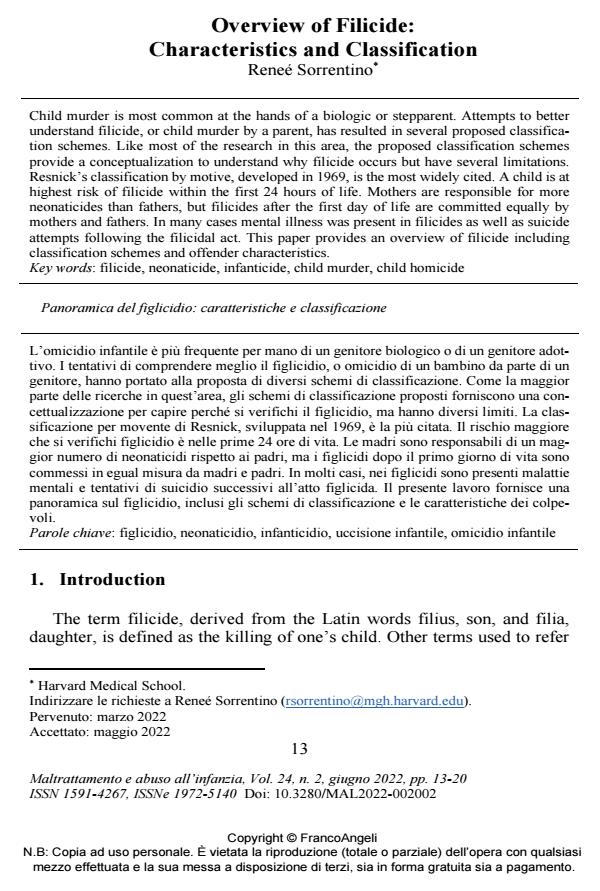Overview of Filicide: Characteristics and Classification
Journal title MALTRATTAMENTO E ABUSO ALL’INFANZIA
Author/s Reneé Sorrentino
Publishing Year 2022 Issue 2022/2
Language English Pages 8 P. 13-20 File size 164 KB
DOI 10.3280/MAL2022-002002
DOI is like a bar code for intellectual property: to have more infomation
click here
Below, you can see the article first page
If you want to buy this article in PDF format, you can do it, following the instructions to buy download credits

FrancoAngeli is member of Publishers International Linking Association, Inc (PILA), a not-for-profit association which run the CrossRef service enabling links to and from online scholarly content.
Child murder is most common at the hands of a biologic or stepparent. Attempts to better understand filicide, or child murder by a parent, has resulted in several proposed classification schemes. Like most of the research in this area, the proposed classification schemes provide a conceptualization to understand why filicide occurs but have several limitations. Resnick’s classification by motive, developed in 1969, is the most widely cited. A child is at highest risk of filicide within the first 24 hours of life. Mothers are responsible for more neonaticides than fathers, but filicides after the first day of life are committed equally by mothers and fathers. In many cases mental illness was present in filicides as well as suicide attempts following the filicidal act. This paper provides an overview of filicide including classification schemes and offender characteristics.
Keywords: filicide, neonaticide, infanticide, child murder, child homicide
- Bourget, D. & Gagne, P. (2005). Paternal Filicide in Québec. The Journal of American Academy of Psychiatry and Law, 33(3), 354-360.
- Bourget, D., Grace, J., & Whitehurst, L. (2007). A Review of Maternal and Paternal Filicide. The Journal of American Academy of Psychiatry and Law, 35(1), 74-82.
- Campion, J. F., Cravens, J. M., Covan, F. (1988). A Study of Filicide Men. The American Journal of Psychiatry, 145(9), 1141-1144, DOI: 10.1176/AJP.145.9.1141
- Daly, M., & Wilson, M. I. (1994). Some Differential Attributes of Lethal Assaults on Small Children by Stepfathers versus Genetic Fathers. Ethology and Sociobiology, 15, 207-217, DOI: 10.1016/0162-3095(94)90014-0
- D’Orban, P. T. (1979). Women Who Kill their Children. The British Journal of Psychiatry, 134, 560-571,
- Fox, J. A. (2007). Homicide trends in the United States. BJS: Bureau of Justice Statistics. Retrieved from the Bureau of Justice Statistics. -- (disponibile online: https://bjs.ojp.gov/library/publications/homicide-trends-united-states).
- Friedman, S. H., Horwitz, S. M., Resnick, P.J. (2005). Child Murders by Mothers: Critical Analysis of the Current State of Knowledge and a Research Agenda. The American Journal of Psychiatry, 162(9), 1578-1587, DOI: 10.1176/APPI.AJP.162.9.1578
- Friedman, S. H., & Resnick, P. (2007). Child Murder by Mothers: Patterns and Preventions. World Psychiatry: official journal of the World Psychiatric Association (WPA), 6(3), 137-141.
- Friedman, S. H., & Resnick, P. J. (2011). Child Murder and Mental Illness in Parents: Implications for Psychiatrists. The Journal of Clinical. Psychiatry, 72(5), 587-588,
- Guileyardo, J. M., Prahlow, J. A., & Barnard, J. J. (1999). Familial Filicide and Filicide Classification. American Journal of Forensic Medicine and Ppathology, 20(3), 286-292, DOI: 10.1097/00000433-199909000-00014
- Léveillée, S., Marleau, J. D. & Dubé, M. (2007). Filicide: A comparison by sex and presence or absence of self-destructive behavior. Journal of Family Violence, 22(5), 287-295,
- Lexico. (n.d.) Filicide. In Lexico.com dictionary. Retrieved April 27, 2022 from https://www.lexico.com/en/definition/filicide.
- Marleau, J. D., Poulin, B., Webnack, T., Roy, R., Laporte, L. (1999). Paternal Filicide: A Study of 10 Men. Canadian Journal of Psychiatry. Revue Canadienne de psychiatrie, 44(1), 57-63, DOI: 10.1177/070674379904400107
- Mariano, T., Chan, H. C., Myers, W. C. (2014). Toward a More Holistic Understanding of Filicide: A Multidisciplinary analysis of 32 years of U.S. Arrest Data. Forensic Science International, 236, 46-53,
- Meyer, C., & Oberman, M. (2001). Mother Who Kill Their Children: Inside the Minds of Moms from Susan Smith to the “Prom Mom” New York, NY: New York University Press.
- Raymond, S., Ducasse, M., Azoulay, M. (2021). Maternal Filicide and Mental Illness: A Descriptive Study of 17 Women Hospitalized in a French Secure Unit Over a 24- Year Period. Journal of Forensic Sciences, 66, 1818-1828, DOI: 10.1111/1556-4029.14780
- Resnick, P. J. (1969). Child Murder by Parents: A Psychiatric review of filicide. American Journal of Psychiatry, 126 (3), 325-334,
- Resnick, P. J. (1970). Murder of the newborn: A Psychiatric Review of Neonaticide. American Journal of Psychiatry, 126(10), 1414-1420,
- Resnick, P. J. (2016). Filicide in the United States. Indian Journal of Psychiatry, 58(2), S203-S209, DOI: 10.4103/0019-5545.196845
- Scott, P. D. (1973). Parents Who Kill their Children. Medicine, Science and the Law, 13(2), 120-126, DOI: 10.1177/002580247301300210
- Sidebotham, P. & Retzer, A. (2019). Maternal Filicide in a Cohort of English Serious Case Reviews. Archives of Women’s Mental Health, 22(1), 139-149,
- United Nations Office on Drugs and Crime [UNODC]. (2019). Global Study on Homicide. Vienna, -- (disponibile online: https://www.unodc.org/unodc/en/data-and-analysis/global-study-on-homicide.html).
- West, S. (2007). An Overview of Filicide. Psychiatry (Edgemont), 4(2), 49-57.
- West, S., Friedman, S. H., & Resnick, P. J. (2009). Fathers Who Kill Their Children: An Analysis of the Literature. Journal of Forensic Sciences, 54(2), 463-468,
Reneé Sorrentino, Overview of Filicide: Characteristics and Classification in "MALTRATTAMENTO E ABUSO ALL’INFANZIA" 2/2022, pp 13-20, DOI: 10.3280/MAL2022-002002